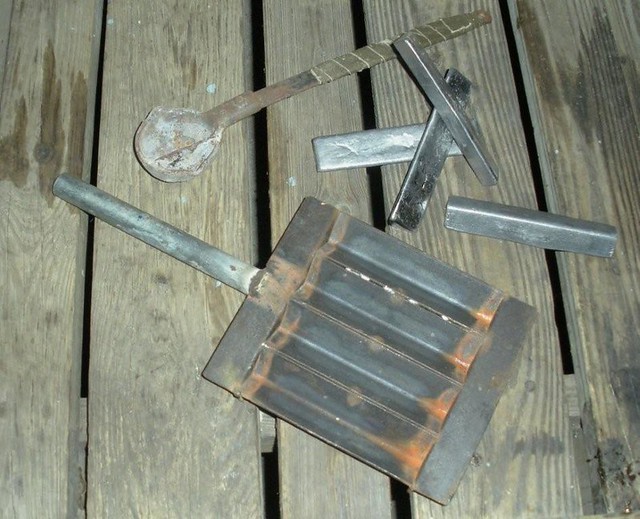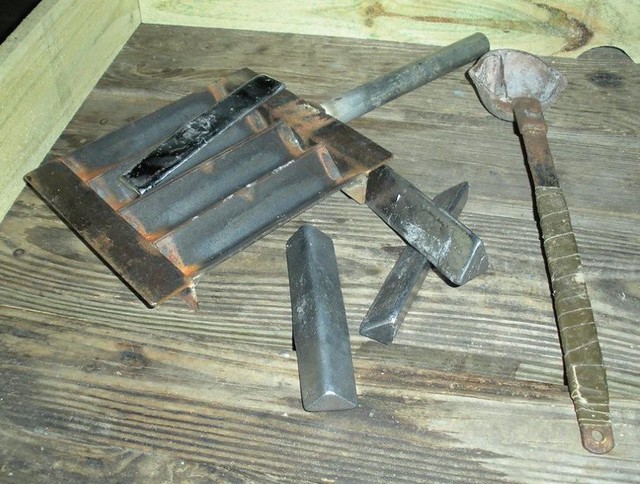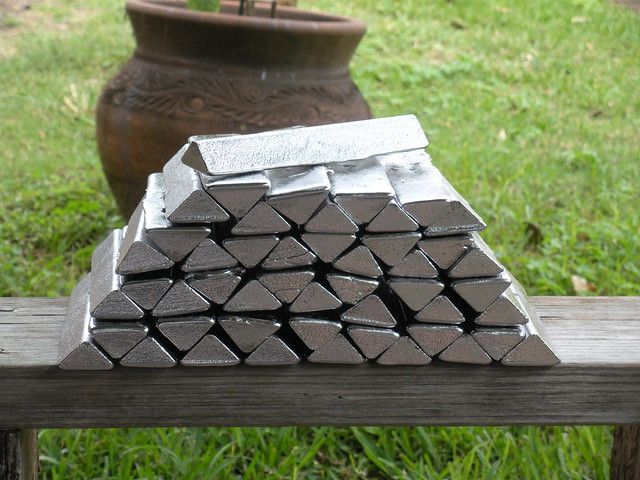Enneybody here have any actual experience casting lead into wood? I have been told that after a couple casts the char will prevent further burning. But, I really dunno :idunno: if it works like that. Would be easy enuf to find out. I could drill a couple holes with a Forstner bit about 1" deep into 2x4 scrap for a test. But, would like experienced feedback first.
You are using an out of date browser. It may not display this or other websites correctly.
You should upgrade or use an alternative browser.
You should upgrade or use an alternative browser.
casting into wood
- Thread starter Rifleman1776
- Start date

Help Support Muzzleloading Forum:
This site may earn a commission from merchant affiliate
links, including eBay, Amazon, and others.
Not for bullets.
I did cast a lead centerboard weight for a wood board and the wood mold was only used once. It works but you'd likely have to go 10% undersize to begin with. But that was a goodly size (10 lb) puck of lead and took some time to cool down.
I used plain 'ol 2x4 pine and it did catch flame around the upper rim but mostly held the shape. As I recall it "ate" into the end grain more in spots - but for my use that was beneficial as I was epoxying it in place in a plywood board and the rough surface just meant better surface for the epoxy.
Probably depends on the wood used. DO NOT soak the wood first thinking that will prevent burning (steam explosion).
I did cast a lead centerboard weight for a wood board and the wood mold was only used once. It works but you'd likely have to go 10% undersize to begin with. But that was a goodly size (10 lb) puck of lead and took some time to cool down.
I used plain 'ol 2x4 pine and it did catch flame around the upper rim but mostly held the shape. As I recall it "ate" into the end grain more in spots - but for my use that was beneficial as I was epoxying it in place in a plywood board and the rough surface just meant better surface for the epoxy.
Probably depends on the wood used. DO NOT soak the wood first thinking that will prevent burning (steam explosion).
Thanks guys. :grin: That's what I was looking for. I would only cast ingots this way. Besides, I like to play with new ideas.
Please be sure the wood is very dry!
Nasty situation if moisture is in the mold area.
Fred
Nasty situation if moisture is in the mold area.
Fred
- Joined
- Jan 3, 2013
- Messages
- 20,091
- Reaction score
- 1,026
Rifleman1776 said:Enneybody here have any actual experience casting lead into wood? I have been told that after a couple casts the char will prevent further burning. But, I really dunno :idunno: if it works like that. Would be easy enuf to find out. I could drill a couple holes with a Forstner bit about 1" deep into 2x4 scrap for a test. But, would like experienced feedback first.
Hey Bro!...
I made a round ball mold out of wood, and a 28 gauge slug mold.
Once it is charred it will not burn...The lead also cools too quickly to set it on fire.
Mine were "poof of concept" molds made out of pine. I made them like commercial blocks but without handles....I used small diameter dowel rod for the alignment pins....
They were functional but nothing like a precision mold.....
If wood is what you want that should work fine but there are lots out there that you can use to make ingots. Aluminum or cast iron works best. Allot of people use muffin pans or the corn cob corn bread pans. I got something, don't know what it is but it's like a muffin pan only allot shallower. Like 3/8" deep. Works good for small ingots. I like small ingots because they don't change the lead melt temp much when adding as I cast.
- Joined
- Jul 15, 2007
- Messages
- 1,996
- Reaction score
- 655
Got an old bed frame laying around somewhere?
Pour a long triangular casting into a five or six foot length of angle iron, making the casting as thin or thick as you want. Then cut the long casting into ingots of any length you want using a hammer and chisel, or hammer and old heavy bladed knife, or hammer and hatchet.
OR If you weld or know someone who does, make an angle iron ingot mold.



Pour a long triangular casting into a five or six foot length of angle iron, making the casting as thin or thick as you want. Then cut the long casting into ingots of any length you want using a hammer and chisel, or hammer and old heavy bladed knife, or hammer and hatchet.
OR If you weld or know someone who does, make an angle iron ingot mold.



- Joined
- Jan 3, 2013
- Messages
- 20,091
- Reaction score
- 1,026
Cool!.... :thumbsup:
I cast a lot of detail parts in open faced molds backed with wood. The masters were made in styrene and then the mold itself was formed by covering the master with furnace cement which copied the details and gave me a mold with the back side open. Since the items were relatively thin and meant to be glued to wood the back needed to be smooth. The solution was to cut a piece of wood of the right size and clamp the two together. I used a small Vise Grip quick clamp carefully adjusted so as to not crack the mold. I had to scratch some lines from the cavity to the top edge of the mold to allow air to escape while pouring. I used a bottom pour furnace and could cast fairly rapidly. The first few using a new piece of wood usually were bad because of the moisture in the wood but they came out fine as the wood dried. After a bit the wood began to char with no negative effect on the casting. Eventually the charring would become a problem but the solution was as simple as throwing the backer away and replacing it with another precut one. After a few hundred castings the furnace cement would degrade but that wasn't much of an issue as a replacement was easily made.
Thanks guys. That's what I was looking for. I would only cast ingots this way. Besides, I like to play with new ideas.
I have a couple of wooden "ingot molds", one casts a pound, and one casts 1/4 pound. I wanted longer, thinner portions of lead to represent what a person might carry in a shooting bag to cast ball. I read somewhere that they break up the ingots with a 'hawk..., and you can't do that with the ingots you get from a LEE ingot mold. :shocked2: I also carved in a King's broad arrow /|\ to show it was property of The King (Hey my online moniker is "Loyalist" Dave :grin: ) So this would've possibly been lead given as Indian "gifts".
I carved into pieces of pine 2x4..., no worries
LD
running horse
40 Cal.
- Joined
- Jan 31, 2014
- Messages
- 155
- Reaction score
- 2
For carrying lead in your bag would it be easier to cat ingots in your ladle? Pop one in hat it up and pour. No worries about it not fitting wire rite and losing a little over the edge. Just a thought.
Similar threads
- Replies
- 92
- Views
- 6K




